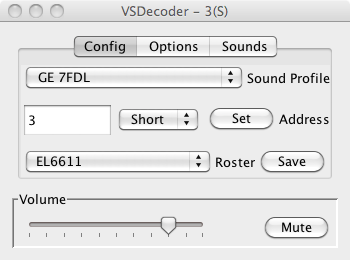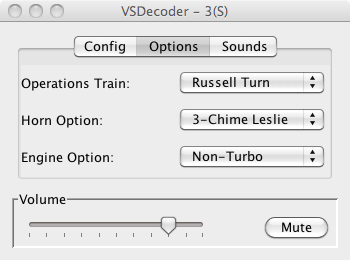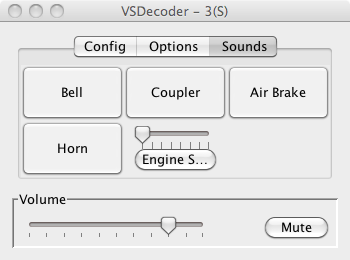- Installing JMRI
- Using DecoderPro®
- DecoderPro® Programming Modes
- The Basic Programmer
- The Comprehensive Programmer
-
- Set-up and Roster Panes
- Expanded Basic Pane
- Motor Control Pane
- Speed Control Pane
- Speed Table Pane
- Function Mapping Pane
- Function Labels Pane
- Lights Pane
- Consisting Pane
- Advanced Features Pane
- Analog Controls Pane
- Sound Pane
- Sound Levels Pane
- Global CV Pane
- Manufacturer-Specific Pane
- Printing the Decoder Data
- DecoderPro® Main Window
- Creating a Decoder Definition
- Error Messages
DecoderPro® Debug Menu
Virtual Sound Decoder
Virtual Sound Decoder
The Virtual Sound Decoder provides a way for those who do not have sound-equipped locomotives (or who are not satisfied with the hardware sound decoder options in smaller scales) to enjoy throttle-controlled locomotive sounds from their computer speakers.
How it works
Locomotive sound "Profiles" are stored in a file called a "VSD File". When the Virtual Sound Decoder ("VSDecoder" or "VSD") is launched, the user chooses the desired Profile, and then assigns the Decoder an address. When the operator then controls the engine by pressing function buttons or changing the speed, the Virtual Sound Decoder responds just like a hardware sound decoder installed in the locomotive would by playing sounds through the computer speakers.
OpenAL Required
Virtual Sound Decoder requires that your system have the OpenAL audio system installed. OpenAL is available free from Creative Labs. You can download the installer for your operating system from the OpenAL site.
If you do not have OpenAL installed, Virtual Sound Decoder will seem to work, except you will get no sound output.
Please NOTE: OpenAL is a separate project from JMRI and is neither maintained nor controlled by the JMRI team.
Virtual Sound Decoder dialog
The Virtual Sound Decoder dialog is launched from the Debug menu. It provides several tabs that allow you to configure and control your locomotive sounds. Each VSDecoder dialog represents and controls sounds for a single locomotive. Multiple dialogs can be launched to provide sound for multiple locomotives.
Menu Items
Load VSD File
Load the Sound Profiles from a VSD File. Profiles loaded will be available to any currently running or newly launched VSDecoder.
VSDecoder Preferences
Set preferences for VSDecoder operation. See below for details.
Volume / Mute control
At the bottom of the window is a master volume slider and mute button. These control the overall sound level for this locomotive, and affect all sounds generated by this VSDecoder window.
Config Tab

The Config tab allows you to select a Sound Profile and assign it to a locomotive.
Profile ComboBox
The Profile ComboBox allows you to select one of the currently loaded Sound Profiles. If the box is empty, use the Load VSD File menu item (or select a Roster Entry - see below) to load a profile.
Address Select
Use the text box and short/long chooser to set the DCC decoder address for this VSDecoder. This number should match the DCC decoder address of the locomotive you want the sounds to follow. Press "Set" to assign the address.
Roster Select and Save
The Roster chooser allows you to select a locomotive from your Roster. The DCC Decoder Address will be automatically set to match the Roster entry. If you have previously saved a VSDecoder profile to that Roster entry (see below), this profile will also be automatically set.
Click the "Save" button to store the currently selected Profile to the currently selected Roster entry. The next time this Roster entry is selected, the Profile will be automatically loaded and set.
WARNING: There is a bug here. The "Save" button does NOT save the Roster entry change to disk. You will have to Edit the Roster entry (from the top-level "Roster->Edit..." menu item) and Save the Roster entry for the changes to persist after you close DecoderPro.
Options Tab

The Options tab allows the user to select various options for the selected Profile. For example, a particular Profile may allow a choice of several different horn sounds, or turbo/non-turbo versions of an engine. Selections here will vary depending on the chosen Profile.
At this time, these features are not available, so the selectors shown are for demonstration only - they are non-functional.
Operations Train Selector
The one functional selector on this page allows the user to choose a Train to follow from the JMRI Operations feature. The VSDecoder will then use physical location information set for each of the Locations the Train visits to change the apparent source location of the engine sounds.
This feature provides a very basic, crude method of providing some location following of the sound.
To set the locations, open the Locations Table by selecting "Operations->Locations" from the main window, and then choose "Tools->Set Physical Locations".
The "origin" (0,0,0) is the listener's position. +X is to the listener's right, +Y is directly in front of the listener, and +Z is up. Units are arbitrary but must be consistent.
Sounds Tab

The Sounds tab provides a series of buttons that allow the user to directly play the available sounds from the computer screen, without using a Throttle. The buttons shown vary depending on the available sounds in the selected Profile.
Engine Start Button and Slider
To start the Engine, press the "Engine Start" button. This will cause a start-up sound to be played, and then will enable the Engine sound to follow the Throttle setting for the selected locomotive. Pressing the Engine Start button again will play a shut-down sound to be played and silence the engine.
By default, the Engine sounds will not play until the Engine Start button has been pressed. If you prefer Engine sounds to play as soon as the Throttle is changed, this feature can be disabled via the VSDecoder Preferences.
The slider just above the Engine Start button is an indicator of which "notch" the Engine is in. The slider does not control anything. Just as on the prototype, the slider (and the engine sound!) follows the Throttle setting, not the actual locomotive speed.
VSDecoder Preferences
The VSDecoder Preferences pane allows the user to change various preferences in how the VSDecoder works.
Auto Start Engine
If checked, the Engine sounds will react immediately to Throttle changes, without the Engine Start button first having to be pressed.
Auto-Load VSD File
If checked, the VSD File listed in the Default VSD File Path field will be automatically loaded on start-up. This can save a step for frequently used VSD Files.
Listener Position
These entries allow the Listener Position to be set relative to the user-chosen Origin of the sound field. Bug Note: The current implementation of the underlying audio system forces the listener position to be (0,0,0), so this preference is non-functional.Cancel / Apply / Save Buttons
Choose Cancel to cancel changes to the Preferences
Choose Apply to apply changes to the Preferences
Choose Save to save changes to the Preferences